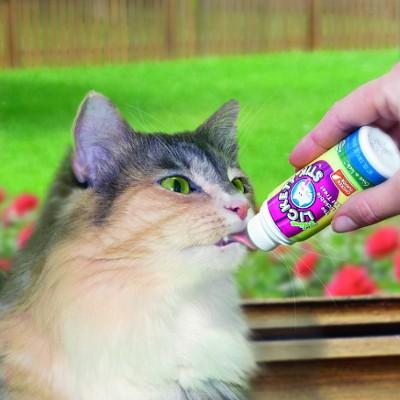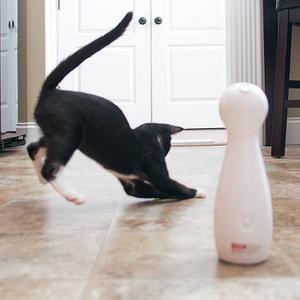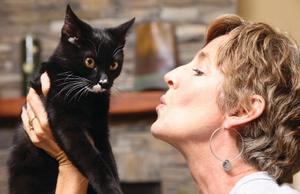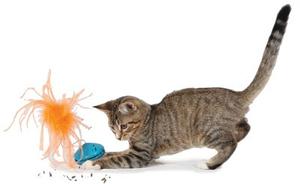By Jacqueline Munera
For a cat lover like me, working with shelter cats is always a risk. I thought the walls around my heart were pretty solid, but Daphne really spoke to me. She had been brought to the shelter when her owner was deployed overseas and couldn’t find anyone to care for her. She didn’t do well in the shelter, not that anyone really does. She bit two people, one of which was me. Since I had apparently provoked her into chomping me, it was obvious the right thing to do was to take her home rather than allow her to be euthanized.
At least, that was the way I rationalized my appearance at the house with a fourth cat! In the past year, Daphne has taught me so much about bravery, perseverance, and love. I have always been opposed to declawing cats. I believe they wouldn’t have been designed with them if they didn’t need them. Daphne had previously been declawed on all four paws, so she was the first no-nail cat I had ever welcomed into my home. The first time I picked her up, she tried to push off my arm and it didn’t hurt me a bit. That was pretty great! However, watching her fall, seeing her atrophied paw pads, watching her limp, and witnessing some of the most exaggerated defensive behavior I have ever seen was not so great.
During the challenge of integrating Daphne into my home, my inner detective and researcher embraced the opportunity to gather information that would benefit all cats. Domestic cats are a digitigrade species, which means they walk on their toes rather than the soles of their feet like humans. Declawing is an amputation of the first joint of the cat’s toe. Imagine having your toes cut off at the first joint and then having to walk on the stumps rather than the soles of your feet.
If someone did that to me, I would be pretty unhappy just like Daphne was! Then an even bigger challenge hit us: vaccine associated sarcoma and rear leg amputation. My tentative foray into mitigating the impacts of declawing on cat structure, movement and behavior became a serious search for physical therapy and rehab sources for Daphne.
There are veterinarians and vet techs that specialize in physical therapy/rehab for cats and dogs (www.rehabvets.org/Referrals.lasso) but most of them primarily focus on dogs. Besides, I felt that the entire vet process would be highly stressful for Daphne. So I continued to dig up ways to provide PT/rehab for Daphne at home in order to help with the prior damage from the declawing and the added challenge of the leg amputation.
Unfortunately, there is a dearth of resources on cat physical therapy and post-surgery rehabilitation. However, with a bit of creativity, many concepts found in the canine and equine fields can transfer successfully to the cat world. For example, a friend sent me video of her senior cat Peanut following a target stick around in the bathtub in order to build-up her strength without stressing her joints. She was inspired to teach Peanut to do this after taking one of her dogs for hydrotherapy sessions. Click here to watch a video of Peanut!
It turned out that I already had some of the best rehab tools in the house. I discovered that target sticks and food puzzle toys are not just fun, they are actually useful for improving your cat’s balance and for building up muscle strength and stamina after surgery. They are also perfect for encouraging your cat to stretch and improve flexibility in a really fun way!
I took a video of Daphne during one of her early rehabilitation sessions with the Egg-cersizer. Click here to watch the video!
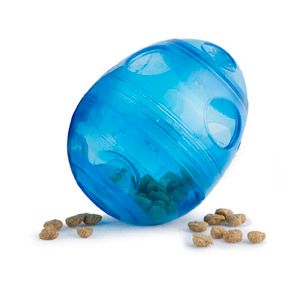 Gentle stretching and massage are another commonly used rehab technique used with canine and equine athletes. This can be just as beneficial for cats. There are several DVDs and books available on using inflatable balls to help stretch and strengthen dogs, and the exercises can easily be modified for use with a cat.
Gentle stretching and massage are another commonly used rehab technique used with canine and equine athletes. This can be just as beneficial for cats. There are several DVDs and books available on using inflatable balls to help stretch and strengthen dogs, and the exercises can easily be modified for use with a cat.
When it comes to massage, cats have their own books! One of my favorites is The Healing Touch for Cats (2004) by Michael W. Fox. As with any type of training, owners should start at a level in the cat’s comfort zone and gradually progress to the goal behavior. Think of it as teaching your cat a new trick, except these tricks help them heal!
Of course, always check with your veterinarian before beginning a physical therapy or rehab plan, because some activities are off-limits depending on your pet’s injury, surgery or condition. Your vet can also help guide you on supplements and medications that reduce pain and inflammation, and may even help prevent and heal joint damage.
New procedures and techniques come out every day so don’t give up on helping your cat whether they have had injury, amputations, or are elderly with arthritis. Physical therapy techniques can really help many cats, like Daphne, have healthier happy lives!
ABOUT JACQUELINE Jacqueline Munera is an IAABC Certified Cat Behavior Consultant and is co-instructor of the Companion Animal Sciences Institute’s Diploma of Feline Behavior program. Jacqueline presents nationally and internationally on a variety of cat training and behavior topics.
As owner of Positive Cattitudes, Jacqueline Munera coaches human clients on how to live in harmony with their cats and dogs, while encouraging people to push the boundaries of what they think cats are capable of. She is especially interested in promoting positive attitudes about cats and is passionate about using operant conditioning techniques to improve the lives of cats everywhere. You can see some of her cat training videos on her channel at www.youtube.com/user/PositiveCattitudes .

